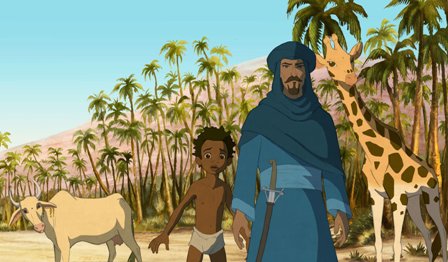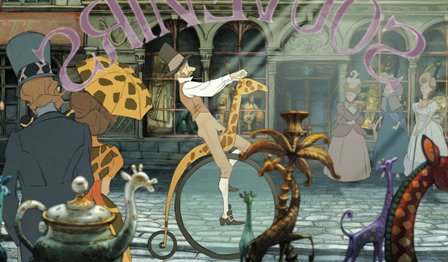Maven's Nest
Reel Life: Flick Pix

Thrilling and charming adventure inspired by a real children (and adults) giraffe-mania
ZARAFA
Directed by Rémi Bezançon and Jean-Christophe Lie
Produced by Valérie Schermann and Christophe Jankovic
Written by Rémi Bezançon and Alexander Abela; English Adaptation byStephanie Sheh
Released by GKIDS
France/Belgium. 78 min. Not Rated
Released in 2 versions: in French with English subtitles and in English
at 2012 Rendez-Vous with French Cinema of Film Society of Lincoln Center
By Nora Lee Mandel
Zarafa has everything I looked for in a film for my own kids – a high-quality, gorgeous looking, entertaining, child-focused, attention-keeping tale that also imparts history with social significance, cultural diversity and the value of passing on stories. Paying tribute to and drawing on classics (literally – this isn’t computer animation), the first half displays the cruelty and potential of nature and man, and the second half travels to “civilization” from the ruins of ancient Egypt on across the continents, that could be new chapters in 1,001 Arabian Nights. Unusually, director/writer Rémi Bezançon and co-director animator Jean-Christophe Lie create this thrilling and charming adventure from an original script that is inspired by a real event that set off giraffe-mania among French children (and adults) in the early 19th century.
The opening sequence in Sudan is comparably scary to Bambi’s threats. Maki, the boy, and the girl, Soula, are chained up by the marauding French slave trader Moreno, who ransacked their villages. Wriggling out of the chains at night, Maki runs, dodging a big crocodile and the slaver’s vicious dog, in a chase like from Uncle Tom’s Cabin. After the boy drags himself to precarious shelter in a big baobab tree (like the ones so prominent in Kipling’s Just So Stories and Antoine de Saint-Exupéry’s The Little Prince), in the future a sage old Storyteller at the base of the tree is reassuringly holding up the wooden figure of Maki to a spellbound group of village children, and tantalizing them with a carving of a giraffe – zarafa in Arabic.
Because a mama giraffe is looming over Maki in the morning, taking him for a fun, bumpy ride to a mud-farting hippo-filled watering hole along with her baby. But Soula is being dragged along with other captured Africans, even while the determined trader whips his horse to collapse in his obsessive hunt – followed by the mysterious, turbaned Bedouin Hassan (voiced by Simon Abkarian in the French version). Shots are fired, Hassan blocks the trader, but, like in Disney movies, the mother giraffe dies in the boy’s arms, and he promises to protect her baby.
“Go home!” insists the Bedouin, but Maki, the original “Lost Boy of Sudan”, has nowhere to go except following him and the baby giraffe, who is now headed to Alexandria to be a gift for the Pasha of Egypt. The animation is like a stunning Cinemascope panorama, to strains of Arab motifs, as they trek through all the terrains of North Africa, from savannah to forest, up through rocky mountains, rolling down big sand dunes, in a sandstorm, under a red hot sun. Through it all Maki stubbornly pursues (like the boy seeking Paulo Coelho's The Alchemist), and Hassan watches from afar, dropping a water bag for him. Walking on, the boy staggers toward an oasis mirage --- and the film briefly shifts ahead to the old Storyteller, to confirm that his little audience is more familiar with sun-baked illusions than American kids are.
Under a night of stars as beautiful as the day scenes, Hassan rescues the collapsed Maki – because the lonely giraffe has refused to drink without him. The nomad teaches him navigation: “Ask the sky for your way.” At the real oasis is the jolly merchant Mahmoud (the only similarity to Disney’s Aladdin), whose idea of a tough negotiation is to beg the Bedouin to take off his hands twin “sacred cows from Tibet” – two inseparables for the price of one. (Back to the Storyteller advising his class how the two cow figurines differ.) Hassan keeps trying to leave Maki and one cow on caravans of camels, but the animals and the boy continually, and amusingly, thwart him to get back together. The giraffe needs mothering with milk, and Maki needs a father, especially when the slaver’s ship (with Soula imprisoned on board) are glimpsed on the Nile into Egypt.
Ironically, the slaver is welcomed back to “civilization" during a noisy war with the Turks, as his ship is the only one allowed through the blockade. Walking from the outskirts of the city through the market and into the Pasha’s palace gardens, the giraffe is such a spectacle, that the Pasha is sure such a gift would impress the King of France to send military aid. But how to get it to Paris? Up above the city is an old friend of Hassan’s, the inventor Malaterre, up in a balloon like a Jules Verne character. How can they all fit in?
With ups and down over the Mediterranean Sea, like Voltaire’s Candide, they take refuge on a Greek pirate ship ruled by the vivacious Captain Bouboulina (in the French version, the throaty-voiced Ronit Elkabetz, one of my favorite actresses), who is especially welcoming to Hassan. Surprise – she was a real entrepreneur, and much of the rest of their strange odyssey is true, after they land in Marseilles and make a sensational odyssey to the capital. While the dangerous Alps were off-route and seem more like a nod to Hannibal crossing with his elephants (though it’s fun seeing the Storyteller explain snow to his wide-eyed listeners), the cows are not just for comic and vulnerable relief (a bit of their Buddhism may help kids process their fate) – bringing them along was why Zarafa made it further and lasted longer than other giraffes sent from Africa.

The filmmakers not only well capture the media sensation of the exotic (with montages based on the actual kitschy commemorations), but also the colonial snobbery of the King’s court and the famous zoologist Geoffroy Saint-Hilaire. Sadly, the crowds at the zoo move on to the Next Big Thing – a hippo. Hassan is laid low by his failed mission, Malaterre is underemployed, and the travelers nearly lose their dignity (and worse when the vengeful slaver returns). Until Zafara speaks to their hearts and helps them -- including Soula and the Old Storyteller – find their homes, and the rapt children their heritage.
The estimable GKIDS has distributed two other distinctive animated films that have covered some of the same geographic territory -- Michel Ocelot’s Azur & Asmar (2006) and Antoine Delesvaux and Joann Sfar’s The Rabbi’s Cat (Le chat du rabbin) (2011). Each is a unique and colorful journey through time and space for children and adults.
N.B. Professor Heather Sharkey, of the University of Pennsylvania, compiled the factual history that was the inspiration, but I don’t agree with her harsh interpretation of the film.
7/12/2015
Nora Lee Mandel is a member of New York Film Critics Online and the Alliance of Women Film Journalists. Her reviews are counted in the Rotten Tomatoes TomatoMeter:
 Complete Index to Nora Lee Mandel's Movie Reviews
Complete Index to Nora Lee Mandel's Movie Reviews
Since August 2006, edited versions of many of my reviews of documentaries/indie/foreign films are at Film-Forward; since 2012, festival overviews at FilmFestivalTraveler; and, since 2016, coverage of women-made films at FF2 Media. Shorter versions of my older reviews are at IMDb's comments, where non-English-language films are listed by their native titles.
To the Mandel Maven's Nest Reel Life: Flick Pix
Copyright © 2018



